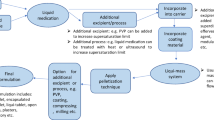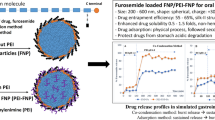Abstract
Purpose
To achieve linear delivery of a highly water-soluble oral drug, verapamil, with a nanofibrous sheet-based system.
Methods
The nanofibrous sheets made of poly (lactic-co-glycolic acid) were used as a diffusion barrier to cap a tablet containing verapamil. For controlled drug delivery, we varied the sheet thickness to 20 μm, 50 μm and 80 μm to give the capped drug tablets, 20CT, 50CT and 80CT, respectively.
Results
Drug release was more sustained as the sheet thickness increased. Thus, the periods for almost complete drug release could be extended up to 14 h with the 80 μm-thick sheets. As we assessed the linear least square fits to the in vitro drug release data from the capped tablets, 20CT and 50CT showed a fairly good correlation with linear release. The periods of linear release were 6 h and 8 h for 20CT and 50CT, respectively, both releasing more than 85% drug during this period.
Conclusion
We conclude that a drug tablet capped with nanofibrous sheets is a promising system for linear delivery of a highly water-soluble oral drug.








Similar content being viewed by others
Abbreviations
- 20CT:
-
tablet capped with 20 μm-thick nanofibrous sheets
- 50CT:
-
tablet capped with 50 μm-thick nanofibrous sheets
- 80CT:
-
tablet capped with 80 μm-thick nanofibrous sheets
- DCM:
-
dichloromethane
- DMF:
-
dimethylformamide
- GI:
-
gastrointestinal
- HPMC:
-
hydroxypropyl methylcellulose
- IERs:
-
ion-exchange resins
- NCT:
-
non-capped tablet
- OROS:
-
osmotic-controlled release oral delivery system
- PBS:
-
phosphate buffered saline
- PLGA:
-
poly (lactic-co-glycolic acid)
- THF:
-
tetrahydrofuran
References
Colombo P, Sonvico F, Colombo G, Bettini R. Novel platforms for oral drug delivery. Pharm Res. 2009;26(3):601–11.
Morishita M, Peppas NA. Is the oral route possible for peptide and protein drug delivery? Drug Discov Today. 2006;11(19–20):905–10.
Sastry SV, Nyshadham JR, Fix JA. Recent technological advances in oral drug delivery-a review. Pharm Sci Technol To. 2000;3(4):138–45.
Fasinu P, Pillay V, Ndesendo VMK, du Toit LC, Choonara YE. Diverse approaches for the enhancement of oral drug bioavailability. Biopharm Drug Dispos [Review]. 2011;32(4):185–209.
Stover TC, Kim YS, Lowe TL, Kester M. Thermoresponsive and biodegradable linear-dendritic nanoparticles for targeted and sustained release of a pro-apoptotic drug. Biomaterials. 2008;29(3):359–69.
Sahana D, Mittal G, Bhardwaj V, Kumar M. PLGA nanoparticles for oral delivery of hydrophobic drugs: influence of organic solvent on nanoparticle formation and release behavior in vitro and in vivo using estradiol as a model drug. J Pharm Sci. 2008;97(4):1530–42.
Lee TH, Wang J, Wang CH. Double-walled microspheres for the sustained release of a highly water soluble drug: characterization and irradiation studies. J Control Release. 2002;83(3):437–52.
Yu CY, Zhang XC, Zhou FZ, Zhang XZ, Cheng SX, Zhuo RX. Sustained release of antineoplastic drugs from chitosan-reinforced alginate microparticle drug delivery systems. Int J Pharm. 2008;357(1–2):15–21.
Conley R, Gupta S, Sathyan G. Clinical spectrum of the osmotic-controlled release oral delivery system (OROS*), an advanced oral delivery form. Curr Med Res Opin. 2006;22(10):1879–92.
Anand V, Kandarapu R, Garg S. Ion-exchange resins: carrying drug delivery forward. Drug Discov Today. 2001;6(17):905–14.
Bhoyar P, Biyani D. Formulation and in vitro evaluation of sustained release dosage form with taste masking of metformin hydrochloride. Indian J Pharm Sci. 2010;72(2):184.
Jeong SH, Park K. Development of sustained release fast-disintegrating tablets using various polymer-coated ion-exchange resin complexes. Int J Pharm. 2008;353(1–2):195–204.
Halder A, Sa B. Sustained release of propranolol hydrochloride based on ion-exchange resin entrapped within polystyrene microcapsules. J Microencapsul. 2006;23(8):899–911.
Krishnaiah Y, Karthikeyan R, Gouri Sankar V, Satyanarayana V. Three-layer guar gum matrix tablet formulations for oral controlled delivery of highly soluble trimetazidine dihydrochloride. J Control Release. 2002;81(1–2):45–56.
Conte U, Maggi L, Colombo P, La Manna A. Multi-layered hydrophilic matrices as constant release devices (GeomatrixTM Systems). J Control Release. 1993;26(1):39–47.
Qiu Y, Chidambaram N, Flood K. Design and evaluation of layered diffusional matrices for zero-order sustained-release. J Control Release. 1998;51(2–3):123–30.
Verma R, Krishna D, Garg S. Formulation aspects in the development of osmotically controlled oral drug delivery systems. J Control Release. 2002;79(1–3):7–27.
Malaterre V, Ogorka J, Loggia N, Gurny R. Oral osmotically driven systems: 30 years of development and clinical use. Eur J Pharm Biopharm. 2009;73(3):311–23.
Sharma S, Bhardwaj S, Gaurave MK, Gupta G. Osmotic controlled drug delivery system. Latest Rev. 2008;6:3.
Park CG, Kim E, Park M, Park JH, Choy YB. A nanofibrous sheet based system for linear delivery of nifedipine. J Control Release. 2010.
Boje KM, Sak M, Fung HL. Complexation of nifedipine with substituted phenolic ligands. Pharm Res. 1988;5(10):655–9.
Huang X, Brazel CS. On the importance and mechanisms of burst release in matrix-controlled drug delivery systems. J Control Release. 2001;73(2–3):121–36.
Streubel A, Siepmann J, Dashevsky A, Bodmeier R. pH-independent release of a weakly basic drug from water-insoluble and-soluble matrix tablets. J Control Release. 2000;67(1):101–10.
Inanc B, Arslan Y, Seker S, Elcin A, Elcin Y. Periodontal ligament cellular structures engineered with electrospun poly (DL lactide co glycolide) nanofibrous membrane scaffolds. J Biomed Mater Res Part A. 2009;90(1):186–95.
Ito K, Kondo S, Kuzuya M. A new drug delivery system using plasma-irradiated pharmaceutical aids. IX. Controlled-release of theophylline from double-compressed tablet composed of cellulose derivatives as wall material. Chem Pharm Bull. 2001;49(12):1615–20.
Mex RSQ. Effect of formulation variables on verapamil hydrochloride release from hydrated HPMC matrices. Rev Soc Quim Mex. 2004;48:326–31.
Kim B, Peppas NA. In vitro release behavior and stability of insulin in complexation hydrogels as oral drug delivery carriers. Int J Pharm. 2003;266(1–2):29–37.
Gupta VD. Quantitation and stability of verapamil hydrochloride using high-performance liquid chromatography. Drug Dev Ind Pharm. 1985;11(8):1497–506.
Park HY, Choi CR, Kim JH, Kim WS. Effect of pH on drug release from polysaccharide tablets. Drug Delivery. 1998;5(1):13–8.
Shantha K, Harding D. Preparation and in-vitro evaluation of poly [N-vinyl-2-pyrrolidone-polyethylene glycol diacrylate]-chitosan interpolymeric pH-responsive hydrogels for oral drug delivery. Int J Pharm. 2000;207(1–2):65–70.
Srivastava AK, Ridhurkar DN, Wadhwa S. Floating microspheres of cimetidine: formulation, characterization and in vitro evaluation. Acta Pharm. 2005;55(3):277.
Rautio J, Mannhold R, Kubinyi H. Prodrugs and Targeted Delivery: Towards Better ADME Properties: Wiley-VCH; 2011.
Davis S, Hardy J, Fara J. Transit of pharmaceutical dosage forms through the small intestine. Gut. 1986;27(8):886.
Zong X, Kim K, Fang D, Ran S, Hsiao BS, Chu B. Structure and process relationship of electrospun bioabsorbable nanofiber membranes. Polymer. 2002;43(16):4403–12.
Ellison CJ, Torkelson JM. The distribution of glass-transition temperatures in nanoscopically confined glass formers. Nature Mater. 2003;2(10):695–700.
Yan B, Lu X, Lozano R. Feasibility study on qualification of USP dissolution apparatus 1 and 2 using the enhanced mechanical calibration procedure. Dissolut Technol. 2011;18(2):17–23.
NIHS. Guideline for bioequivalence studies for different strengths of oral solid dosage forms. Japan 2000.
Acknowledgments & DISCLOSURES
This study was supported by a grant of the Korean Health Technology R&D Project, Ministry of Health & Welfare, Republic of Korea (A110962) and grant no 03-2011-0110 from the SNUH Research Fund. The authors thank Hwaryong Kim at the Department of Biomedical Engineering in Seoul National University Hospital for preparation of the aligning and bonding stamps.
Author information
Authors and Affiliations
Corresponding author
Additional information
Ji Eun Lee and Chun Gwon Park contributed equally to this work.
Electronic Supplementary Material
Below is the link to the electronic supplementary material.
ESM 1
(DOCX 189 kb)
Rights and permissions
About this article
Cite this article
Lee, J.E., Park, C.G., An, B.M. et al. Linear Delivery of Verapamil via Nanofibrous Sheet-Based System. Pharm Res 29, 1787–1796 (2012). https://doi.org/10.1007/s11095-012-0702-z
Received:
Accepted:
Published:
Issue Date:
DOI: https://doi.org/10.1007/s11095-012-0702-z




